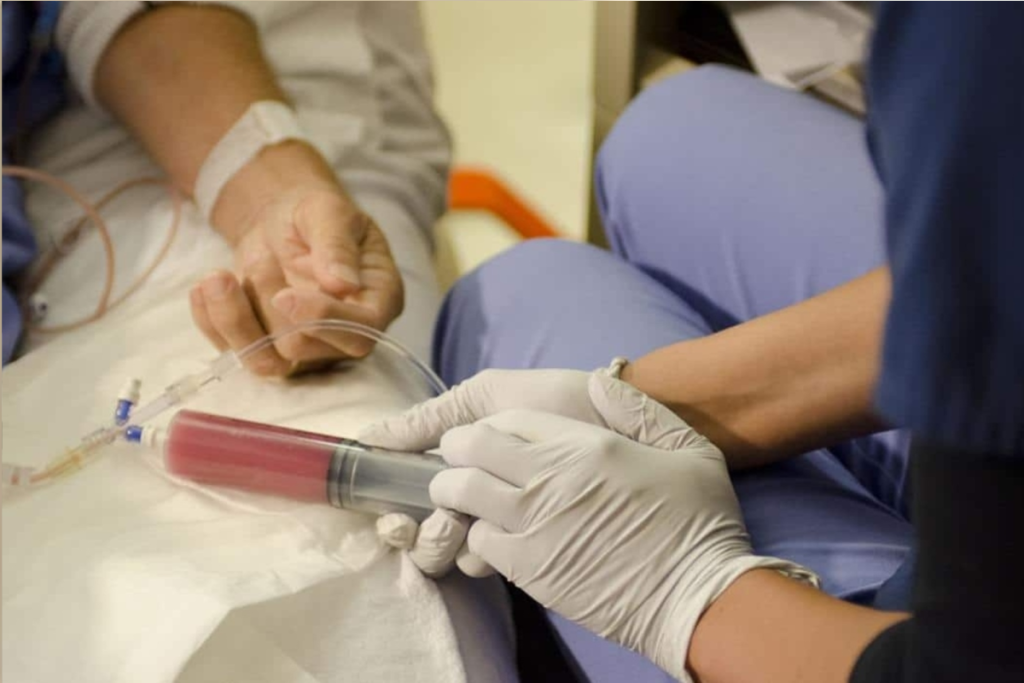
gene therapy cost is a new medical treatment that could change the game for rare genetic diseases. But, its high cost is a big problem for many.
The cost of these treatments is very high. For example, Luxturna costs $425,000 per eye. Zolgensma is even pricier at $2.1 million. And new treatments for sickle cell disease could cost up to $3 million.
Even though these treatments are groundbreaking, their high price is a big challenge. It affects both healthcare systems and patients.
Gene therapy is a new way to treat diseases. It uses genes to help patients with genetic disorders. This method is different from old treatments.
Gene therapy uses genes to prevent or treat diseases. It changes a person’s genes to fix diseases. By adding healthy genes to cells, it aims to fix genetic problems.
“Gene therapy is a revolutionary technology that allows us to treat diseases at the genetic level.” This shows how gene therapy can change medicine.
Gene therapy’s success comes from new ways to get genes into cells safely. Viral vectors, like adeno-associated viruses (AAVs), are key. They can target specific cells to deliver genes.

There are many types of gene therapy. Each works differently and is used for different diseases:
These methods show how gene therapy can treat many diseases.
Gene therapy is changing fast, and knowing its cost is key for patients and doctors. It’s a big step forward in medicine, aiming to cure diseases that were once thought incurable. But, these treatments come with a big price tag.

The cost of gene therapy can be very different, from $425,000 to over $3 million per treatment. This big range comes from many things. For example, the type of therapy, the disease it treats, and how complex the treatment is.
Key factors affecting gene therapy costs include:
It’s important to compare gene therapy costs to traditional treatments. Gene therapy might seem expensive at first. But, it could save money in the long run by avoiding ongoing treatments.
For instance: Traditional treatments for genetic diseases can cost a lot each year. But, a single gene therapy treatment might be cheaper over time.
Gene therapy costs can also change based on where you are. This is because of different healthcare systems, pricing rules, and market conditions. It’s important for patients, doctors, and insurance companies to understand these differences.
Regional factors influencing gene therapy costs:
Gene therapy is changing how we treat diseases. It’s a complex field that aims to treat genetic diseases at their source. But, it comes with a high price tag.
Gene therapy’s high cost starts with research and development. It takes years of work, trials, and approvals. This process is very expensive.
Industry estimates say it can cost $1 billion to $2 billion to bring a gene therapy to market. This includes costs from failed trials and other expenses.
“The development of gene therapies is a high-risk, high-reward endeavor,” a leading expert. “The costs from failed trials and the science’s complexity add up.”
Gene therapies are made one at a time, unlike regular medicines. This custom-making process is complex and expensive. It requires special facilities and skilled workers.
Many gene therapies target rare diseases, affecting few people. This means the cost is spread over fewer patients. It makes these treatments very expensive.
“The economics of gene therapy are challenging due to the small patient populations for many of these treatments,” says an economist. “This limited market size means that the development costs are amortized over fewer patients, increasing the cost per individual.”
Getting a gene therapy approved is also costly. The FDA has strict rules to ensure safety and effectiveness. These rules are important but add to the cost.
The high cost of gene therapy comes from many factors. These include research and development, manufacturing, limited patient numbers, and regulatory hurdles. As the field grows, finding ways to make these treatments more affordable is key.
Gene therapy prices vary a lot. They can cost hundreds of thousands to millions of dollars per patient. This is because of several factors like treatment complexity, patient numbers, and how it’s made.
Luxturna is a gene therapy for inherited retinal disease. It costs $425,000 per eye. Despite being expensive, it greatly improves vision in patients with this rare condition.
Zolgensma is a pricey gene therapy. It’s for spinal muscular atrophy and costs $2.1 million. It replaces a faulty gene, potentially stopping the disease from getting worse.
Gene therapies for sickle cell disease are being developed. They could cost up to $3 million. These treatments aim to fix the genetic issue causing sickle cell disease, potentially curing it.
Follistatin gene therapy is a new treatment with promising results. The exact cost isn’t known yet. It’s expected to be similar to other gene therapies, costing hundreds of thousands to millions of dollars.
In summary, gene therapy prices are very high. As these treatments improve, understanding their costs and access will be key for patients, doctors, and insurance companies.
Gene therapy is growing, and knowing its cost for different conditions is key. The price can change a lot based on the condition, how complex the therapy is, and who it’s for.
Cancer gene therapies are a new hope for some patients. They can cost a lot, from $373,000 to over $500,000. This depends on the therapy and how well it works for each patient.
Therapies for rare genetic disorders like Spinal Muscular Atrophy and Inherited Retinal Disease are getting attention. For example, Zolgensma costs $2.1 million for SMA. Luxturna, for certain eye diseases, is $425,000 per eye. These high prices are because these conditions are rare and the treatments are complex.
Gene therapies are also being made for more common issues like heart disease and some brain disorders. These are just starting, but they could help many people. A report by ICER says their prices will depend on how long treatment lasts, how many people it helps, and how well it works compared to other treatments.
Here’s a chart to help understand gene therapy costs:
The prices for gene therapy vary a lot, showing how complex these treatments are. As the field grows, prices might change based on new research, how treatments are made, and market trends.
Gene therapy is changing healthcare systems around the world. It brings new treatments and big economic challenges. It’s important for healthcare providers, policymakers, and patients to understand these impacts.
Experts predict that the US will spend between $20.4 billion and $25.3 billion on gene therapy each year. This is because gene therapy can cost hundreds of thousands to millions of dollars per patient.
“The high upfront costs of gene therapy are a big worry for healthcare systems,” a report says. “But these therapies could save money in the long run by reducing the need for ongoing treatments.”
By 2034, the US is expected to spend $306 billion on gene therapy. This shows the big financial effect gene therapies will have on healthcare in the next few years.
The global gene therapy market is set to grow a lot. It’s expected to jump from $25.03 billion to $117.46 billion. This growth comes from better technology, more products, and more use of these treatments worldwide.
As the gene therapy market grows, healthcare systems need to plan how to handle the costs. They should look at new payment models, make treatments more accessible, and make sure gene therapy helps all kinds of patients.
Gene therapy is a game-changer, but it faces big hurdles in getting covered by insurance. The cost of these treatments can be in the millions, putting a heavy burden on healthcare and patients.
Insurance for gene therapy varies a lot. Some insurers cover it, but getting approved can be tough. You need to provide a lot of paperwork.
“The complexity of gene therapy pricing and reimbursement is a significant barrier to access,” notes a recent industry report. This makes it hard to understand and get covered.
Medicare and Medicaid are key in covering gene therapies for those who qualify. But, their rules can change a lot.
New payment models are being tried to deal with the high costs of gene therapies. These include paying based on how well the treatment works and plans to pay over time.
Outcome-based payments reward treatments that really help patients, making them more appealing financially.
Installment plans let the cost of gene therapy be paid over years. This makes it easier for healthcare and patients to handle.
As gene therapy grows, so will the ways to pay for it. It’s important for insurers, policymakers, and patient groups to keep talking. This will help make gene therapy more accessible in the future.
Gene therapy cost can reach millions, sparking debates on fairness. The high prices block many patients, leading to disparities in access to gene therapy.
The cost of gene therapy is a big problem. It stops patients from lower income backgrounds or without good insurance from getting treatment.
A gene therapy researcher, says, “The cost of gene therapy is a significant issue that needs to be addressed to ensure equitable access.” This is also mentioned in a
“Gene therapies are often priced out of reach for many patients, highlighting the need for innovative payment solutions and broader insurance coverage.”
A study found that those who got gene therapy were usually wealthier and had better insurance. This shows we need policies to make gene therapy more available to everyone.
Where you live also affects your access to gene therapy. Not all areas have the right treatment centers. Patients may have to travel far, making it harder and more expensive to get care.
Improving the distribution of treatment centers and using telemedicine solutions could help solve these problems.
High prices for gene therapy raise big ethical questions. There’s a debate about if pharmaceutical companies should make their products affordable.
“The pricing of gene therapies must balance the need for innovation with the moral imperative to provide access to those who need it.”
by an industry expert.
Fixing these ethical issues will need a team effort. We need talks between policymakers, healthcare providers, and pharmaceutical companies. Solutions could include price negotiations, value-based pricing models, and expanded insurance coverage for gene therapies.
Gene therapy is changing, and so is its cost. Today, gene therapies are pricey because they’re new and complex. This makes them expensive to develop and make.
Potential for Price Reductions
One big reason for lower gene therapy costs is increased competition. More companies are making gene therapies for the same diseases. This competition could make prices drop.
Also, better manufacturing tech could cut costs. Advances in gene editing, vector design, and making processes could make therapies cheaper.
More competition will shape gene therapy costs. As more therapies get approved, patients will have more choices. This could lead to lower prices.
Technological progress is key to cheaper gene therapies. New gene editing tools like CRISPR/Cas9 and better vector tech can lower costs. They make production more efficient.
Also, making processes better, like automation and scaling up, can save money. These savings might be passed on to patients.
Gene therapy is changing how we treat diseases, bringing hope to many. It’s important to find a way to make these treatments affordable for everyone. This way, more people can get the help they need.
The cost of gene therapy, like Luxturna and Zolgensma, is a big problem. It’s expensive and can make it hard for people to get the treatment. Even though it could save money in the long run, the prices are too high for many.
We need to find new ways to pay for gene therapy. We should also make it cheaper to make and increase competition. This way, we can keep the innovation going while making it more affordable.
In the end, finding a balance between cost and innovation is key. This will help gene therapy reach those who need it most. It’s a step towards a future where everyone has access to these life-changing treatments.
Gene therapy can cost anywhere from hundreds of thousands to millions of dollars. This depends on the condition being treated and the therapy type.
High costs come from research, manufacturing complexity, and limited patients. Regulatory hurdles also play a role.
Gene therapy is pricier than traditional treatments. Yet, it offers long-term benefits. This could lead to lower healthcare costs over time.
Yes, costs differ by region. This is due to healthcare systems, pricing rules, and market conditions.
Luxturna, for inherited retinal disease, costs $425,000 per eye.
Zolgensma, for spinal muscular atrophy, costs $2.1 million.
Gene therapies for sickle cell disease can cost up to $3 million.
Coverage varies by provider and policy. Some insurers cover certain gene therapies, while others do not.
Costs are expected to drop as competition grows and technology improves. Better manufacturing processes will also help.
Gene therapy can offer lifelong benefits. This could reduce healthcare costs by avoiding ongoing treatments and managing chronic conditions.
Follistatin gene therapy costs vary. It’s generally on par with other gene therapies, which range from hundreds of thousands to millions of dollars.
Subscribe to our e-newsletter to stay informed about the latest innovations in the world of health and exclusive offers!
WhatsApp us